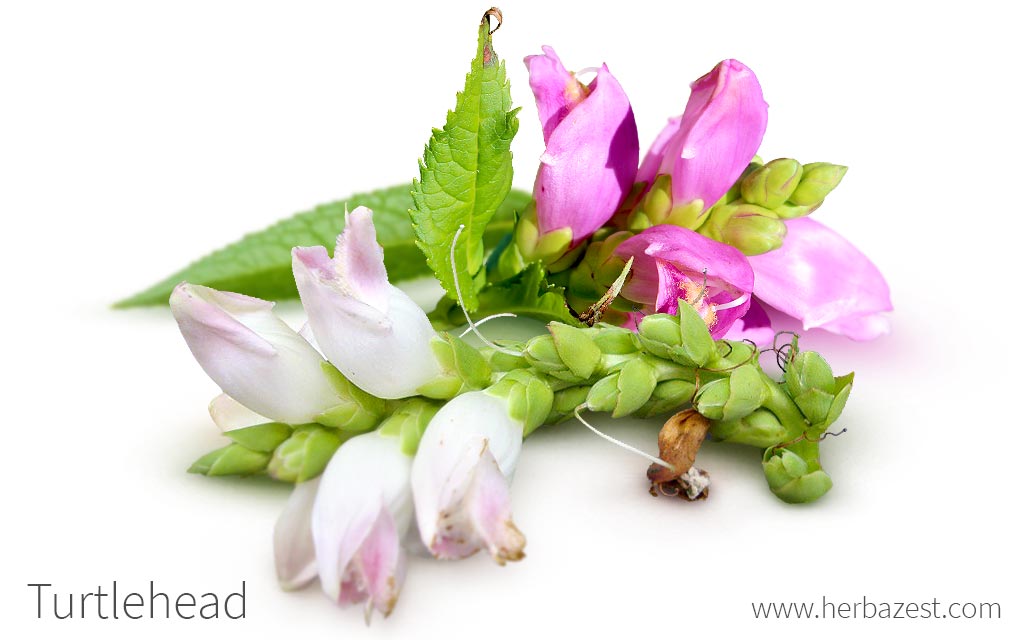Turtlehead grows in swamps and along streams from southeastern Canada and south to Florida and Kansas. The herb was traditionally used by Native Americans and early settlers for liver ailments, parasites, and as an appetite stimulant.
Turtlehead Medicinal Properties
- Medicinal action Cholagogue, Choleretic
- Key constituents Aucubin, catalpol
- Ways to use Decoctions, Hot infusions/tisanes, Tincture
- Medicinal rating (1) Very minor uses
- Safety ranking Safe
Health Benefits of Turtlehead
Although not all of its alleged benefits are backed by science, turtlehead has a long history of medicinal applications. Nowadays, the herb is still used for a variety of purposes, including:
Detoxifying the body. Turtlehead works principally with the liver, gallbladder, and kidneys to rid the body of toxins and infections.
Aiding digestion. The bitter compounds in turtlehead stimulate the secretion of digestive juices, promoting good digestion as well as relieving constipation.
Other conditions aided by turtlehead include hepatic dysfunction, jaundice, gallstones, and inflammation of the gallbladder. It was also traditionally prescribed for the expulsion of roundworms and threadworms.
How It Works
The medicinal properties of turtlehead have not been studied extensively, but it is believed that the herb's actions can mainly be attributed to resins and bitter, laxative iridoid glycosides.
Iridoid glycosides are secondary metabolites present in various plants that have exhibited anti-inflammatory activity.1 Turtlehead contains two major iridoid glycosides, aucubin and catalpol.
Aucubin has been reported to suppress TNF-α, a cell-signaling protein (cytokine) involved in systemic inflammation.2 Catalpol has been shown to have antioxidant, anti-inflammatory, and neuroprotective properties.3
Although the exact mechanism of action of these compounds in turtlehead is yet to be understood, they seem to play a role in the removal of waste materials that tend to accumulate in major organs, such as the liver, gallbladder, and kidneys. It is thought that this is done by stimulating bile secretion, which improves digestion, bowel movements, and kidney function in order to get rid of toxins through the urine.
Moreover, both aucubin and catalpol have a bitter taste, which stimulates the gustatory nerves in the mouth, increasing saliva production and appetite, as well as aiding digestion. By the herb's stimulation of gastric juices, symptoms such as gas, dyspepsia, and poor appetite are relieved.
The anti-inflammatory properties of turtlehead require further investigation before they are fully understood.
TURTLEHEAD STIMULATES APPETITE AND SALIVA PRODUCTION.
Other herbs that help cleanse internal organs and promote good digestion are hepatica, milk thistle, and parsley.
Turtlehead Side Effects
When used in recommended medicinal amounts, there are no reported side effects for turtlehead.
Turtlehead Cautions
No drug interactions have been recorded for turtlehead.
Not enough is known about the medicinal use of turtlehead for women who are pregnant or breastfeeding. Therefore, it is advised to err on the safe side and avoid medicinal consumption.

How to Consume Turtlehead
- Edible parts Leaves
- Taste Bitter
Turtlehead is not usually used in a culinary capacity; however, the dried aerial parts are used for a variety of medicinal herbal remedies.
Natural Forms
Infusion. Fresh or dried, turtlehead leaves can be infused in hot water and drank three times daily for constipation relief as well as for treating liver diseases, worms, and lack of appetite.
Decoction. Boiling the leaves of turtlehead concentrate their medicinal benefits. Turtlehead decoctions have been traditionally applied externally to heal herpes lesions and hemorrhoids.
Poultice. The crushed leaves of the herb can be used topically to treat inflamed breasts, painful ulcers, and piles.
Herbal Remedies & Supplements
Tincture. When diluted in a glass of water (20 - 40 drops) and taken three times daily, turtlehead's tincture is claimed to be useful for indigestion, constipation, and appetite stimulation.
Salve. This is an oily preparation that is applied over the affected area to relieve itching and inflammation.
Capsules. Herbalists often use turtlehead, along with other herbs, in the preparation of capsules, mostly for treating parasites or stimulating liver function.

Growing
- Life cycle Perennial
- Harvested parts Leaves
- Light requirements Full sun, Partial shade
- Soil Light (sandy), Medium (loam)
- Soil pH 6.6 – 7.3 (Neutral)
- Growing habitat Swamps and marshlands, Woodlands
- USDA Plant Hardiness Zones 3a, 3b, 4a, 4b, 5a, 5b, 6a, 6b, 7a, 7b, 8a, 8b
- Pre-germination seed treatment Stratification
- Planting time Spring
- Plant spacing average 0.5 m (1.64 ft)
- Propagation techniques Stem cuttings, Divisions
- Potential diseases Leaf spot, Rust, Powdery mildew
The turtlehead plant, also known as balmony, is commonly grown by gardeners for its late-season blooms. It is usually found in shaded, woodland gardens, water garden peripheries, or native plant gardens, as long as proper soil moisture is met.
Growing Guidelines
The turtlehead plant grows best in soil with a neutral pH level.
All chelone species thrive in partial shade. However, full sun is tolerated as long as the soil stays consistently moist to wet.
Turtleheads will normally begin to bloom in late summer or early fall, usually during the months of July through September.
Root division is believed to be the best method to propagate the turtlehead plant. Planting stem cuttings in late spring to early summer or sowing seeds in the spring are also viable options.
The leaves are harvested during the flowering period.
Serious pest and disease problems are usually not an issue with turtlehead. A few diseases that may affect the plant include powdery mildew, rust, and leaf spots. Mildew will occur if the soil is too wet or if air circulation is poor.
Further information on growing turtlehead can be found in the herb garden section.
Additional Information
Plant Biology
Turtlehead flowers are said to resemble the head of a turtle or snake, from where the common name is derived.
Turtleheads are erect, slender perennials that grow 12 - 48 inches (30 - 120 cm) tall and wide, with a square stem and short-stemmed, sharp-toothed leaves that are three to six inches (8 - 15 cm) long. The flowers vary in color according to the species of turtlehead, but they usually go from pinkish-white to pinkish-purple and grow to about an inch (2.5 cm) in length. They are irregular, two-lipped, and grow in dense spikes.
Classification
All turtleheads belong to the Scrophulariaceae or figwort family. Chelone is a genus of four species of perennial herbaceous plants native to eastern North America: C. glabra (white turtlehead), C. lyonii (Appalachian turtlehead), C. cuthbertii (Cuthbert's turtlehead), and C. obliqua (red or pink turtlehead). All of them are commonly named turtleheads; however, C. glabra is the most widely dispersed of the four.
Varieties of Turtlehead
There are at least nine varieties of Chelone glabra: C. glabra var. chloranta, C. glabra var. dilatata, C. glabra var. elatior, C. glabra var. elongata, C. glabra var. linifolia, C. glabra var. ochroleuca, and C. glabra var. typica, all of them considered as synonyms of C. glabra and collectively identified as white turtlehead.
Historical Information
The Greek word chelone means "tortoise." An Aesop's fable tells the story of a nymph named Chelone who insulted Zeus by refusing an invitation and was turned into a turtle as a punishment. Glabra is a Latin word meaning "smooth" because of the lack of hairs or texture on the stems and leaves.
Turtlehead was traditionally utilized as an appetite stimulant and laxative among Native Americans, while settlers used the herb's leaves to make a tonic to aid with jaundice, constipation, and internal parasites, as well as to relieve itching and inflammation.
Other Uses
Gardening. Because of its pretty flowers, turtlehead is often used as an ornamental plant.
Turtlehead has been acclaimed for centuries for its utility with healing liver ailments, expelling internal parasites, and stimulating appetite. Its traditional uses continue to this day, as well as its more current applications as a laxative and anti-inflammatory aid.
Sources
- Chemical Mediation of Coevolution, p. 144
- CRC World Dictionary of Medicinal and Poisonous Plants, p. 917
- Herbal Folk Medicine: An A to Z Guide
- Medical Herbalism: The Science and Practice of Herbal Medicine, p. 538
- Missouri Botanical Garden, Chelone glabra
- NatureServe Explorer, Chelone cuthbertii
- North Carolina Botanical Garden, Chelone glabra | Chelone lyonii
- PubChem, Aucubin | Catalpol
- Purdue University, Turtlehead
- The Perennial Care Manual, p. 185
- United States Department of Agriculture, Turtlehead (Chelone glabra)
- USDA Forest Service, Turtlehead (Chelone glabra)
- Royal Horticultural Society, Chelone obliqua
Footnotes:
- Current Medicinal Chemistry. (2012). Anti-Inflammatory Iridoids of Botanical Origin. Retrieved August 11, 2021, from https://pubmed.ncbi.nlm.nih.gov/22414102/
- Cytokine. (2013). Aucubin, a naturally occurring iridoid glycoside inhibits TNF-a-induced inflammatory responses through suppression of NF-?B activation in 3T3-L1 adipocytes. Retrieved August 11, 2021, from https://pubmed.ncbi.nlm.nih.gov/23612013/
- Current Medicinal Chemistry. (2015). Catalpol: a potential therapeutic for neurodegenerative diseases. Retrieved August 11, 2021, from https://pubmed.ncbi.nlm.nih.gov/25620103/





